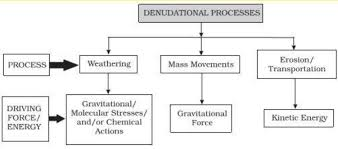Geomorphic Processes – Complete Guide for Class 11 Geography Chapter 5
Welcome to iPrep, your Learning Super App. Our learning resources for the chapter, “Geomorphic Processes”, Continents in Geography for Class 11th are designed to ensure that you grasp this concept with clarity and perfection. Whether you’re studying for an upcoming exam or strengthening your concepts, our engaging animated videos, practice questions and notes offer you the best of integrated learning with interesting explanations and examples.
This chapter explores the various processes that shape the Earth’s surface, including endogenic processes (internal forces) and exogenic processes (external forces). It discusses the role of weathering, mass movements, erosion, and deposition in shaping the landscape.
Geomorphic processes are the natural forces that sculpt the Earth’s surface, creating the diverse landforms we observe today. This chapter delves into the different types of geomorphic processes and their impact on the landscape.
Objectives Of Learning The Chapter – Geomorphic Processes
Now that we have explored the importance of the chapter, let’s outline the objectives of studying it.
- To understand the different types of geomorphic processes.
- To explore the role of endogenic and exogenic processes in shaping the Earth’s surface.
- To analyze the processes of weathering, mass movements, erosion, and deposition.
- To examine the significance of soil formation.
Now let’s explore the various sections of the chapter.
Firstly, in order to understand the internal forces shaping the Earth, let’s delve into the Endogenic Processes section of the chapter “Geomorphic Processes.”
Geomorphic Processes
Geomorphic processes can be broadly classified into endogenic and exogenic processes.
Now, in order to understand the dynamics of Earth’s internal forces, let’s explore the section ‘ENDOGENIC PROCESSES’ of the chapter ‘Geomorphic Processes.’
ENDOGENIC PROCESSES
- Endogenic processes are internal forces that originate within the Earth’s crust. The two major processes are:
Diastrophism
- Refers to the deformation of the Earth’s crust due to tectonic forces.
- Includes processes like folding, faulting, and warping.
Volcanism
- Involves the eruption of magma onto the Earth’s surface, forming volcanic landforms.
- Influences the creation of mountains, plateaus, and other features.
Now, in order to understand the external forces at work, let’s explore the Exogenic Processes section of the chapter “Geomorphic Processes.”
EXOGENIC PROCESSES
Exogenic processes are external forces that shape the Earth’s surface, such as weathering, mass movements, erosion, and deposition.

Weathering
Weathering is the process of breaking down rocks and minerals into smaller particles.
- Three major groups of weathering processes:
Chemical Weathering:
Breakdown of rocks through chemical reactions, often involving water.
Physical or Mechanical Weathering:
Disintegration of rocks without changing their chemical composition.
Biological Weathering:
Involves living organisms, such as plants and animals, contributing to rock breakdown.

SPECIAL EFFECTS OF WEATHERING
Weathering can have significant effects on the landscape, such as exfoliation.
- Exfoliation:
- Exfoliation is a type of physical weathering that occurs in areas with large temperature fluctuations.

SIGNIFICANCE OF WEATHERING
- Weathering is essential for the formation of soil and the development of landscapes.
- Contributes to soil formation and landscape development.
- Provides essential minerals for ecosystems.
Now, in order to understand the movement of Earth materials, let’s delve into the Mass Movements section of the chapter “Geomorphic Processes.”
MASS MOVEMENTS
Mass movements are the downslope movement of soil, rock, or debris.
- Landslides
- Rapid movement of rock and soil down slopes, often triggered by rainfall, earthquakes, or human activities.
- Landslides are a common type of mass movement that can cause significant damage.

Now, in order to understand the transportation and accumulation of materials, let’s explore the Erosion and Deposition section of the chapter “Geomorphic Processes.”
EROSION AND DEPOSITION
- Erosion is the process of wearing away and transporting soil and rock.
- It is the removal and transportation of rock particles by wind, water, ice, or gravity.
- Deposition is the process of depositing eroded material.
- It leads to the formation of new landforms.
Now, in order to understand the development of soils, let’s delve into the Soil Formation section of the chapter “Geomorphic Processes.”
SOIL FORMATION
Soil is formed through the process of soil formation, which involves the interaction of various factors.
- Process of Soil Formation
Soil formation is a slow and gradual process that involves the weathering of rocks, the accumulation of organic matter, and the development of soil horizons.
- Soil-forming Factors
Parent Material: The original rock or sediment from which the soil is formed.
Topography: The landscape position influences drainage, erosion, and soil depth.
Climate: Temperature and precipitation affect the rate of weathering and organic activity.
Biological Activity: Plants, animals, and microorganisms contribute to soil development.
Time: Soil formation is a slow process, taking thousands to millions of years.
Finally, as we have gained comprehensive knowledge about the chapter “Geomorphic Processes”, let’s reflect on the overall learning value of this important lesson.
Overall Learning Value
The chapter “Geomorphic Processes” provides a comprehensive understanding of the forces and processes that continuously shape the Earth’s surface. By examining both endogenic and exogenic processes, students gain insights into the dynamic nature of our planet. The chapter also highlights the significance of weathering, erosion, and soil formation in the development of landforms. Understanding these processes is essential for appreciating the complexity of the Earth’s landscapes and the factors that influence their change over time.
This chapter equips students with the knowledge to analyze and interpret the physical features of the Earth, laying the foundation for further studies in geography and environmental science.
Practice questions on Chapter 5 - Geomorphic Processes
Get your free Chapter 5 - Geomorphic Processes practice quiz of 20+ questions & detailed solutions
Practice Now








